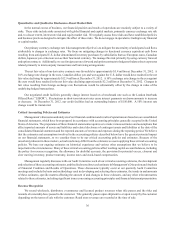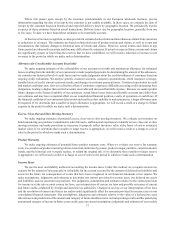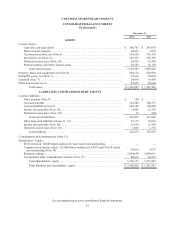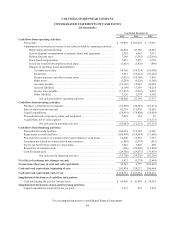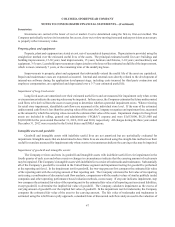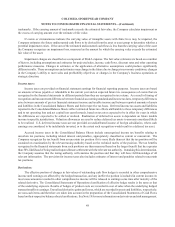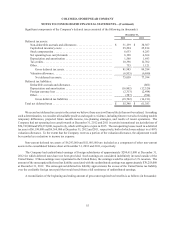Columbia Sportswear 2012 Annual Report Download - page 50
Download and view the complete annual report
Please find page 50 of the 2012 Columbia Sportswear annual report below. You can navigate through the pages in the report by either clicking on the pages listed below, or by using the keyword search tool below to find specific information within the annual report.
COLUMBIA SPORTSWEAR COMPANY
46
NOTES TO CONSOLIDATED FINANCIAL STATEMENTS
NOTE 1—BASIS OF PRESENTATION AND ORGANIZATION
Nature of the business:
Columbia Sportswear Company is a global leader in the design, sourcing, marketing and distribution of active outdoor
apparel, footwear, accessories and equipment.
Principles of consolidation:
The consolidated financial statements include the accounts of Columbia Sportswear Company and its wholly owned
subsidiaries (the “Company”). All significant intercompany balances and transactions have been eliminated in consolidation.
Estimates and assumptions:
The preparation of financial statements in conformity with accounting principles generally accepted in the United
States of America (U.S. GAAP) requires management to make estimates and assumptions that affect the reported amounts
of assets and liabilities and disclosure of contingent assets and liabilities at the date of the consolidated financial statements
and the reported amounts of revenues and expenses during the reporting period. Actual results may differ from these estimates
and assumptions. Some of these more significant estimates relate to revenue recognition, including sales returns and claims
from customers, allowance for doubtful accounts, excess, slow-moving and close-out inventories, product warranty, long-
lived and intangible assets, income taxes and stock-based compensation.
NOTE 2—SUMMARY OF SIGNIFICANT ACCOUNTING POLICIES
Cash and cash equivalents:
Cash and cash equivalents are stated at fair value or at cost, which approximates fair value, and include investments
with original maturities of 90 days or less at the date of acquisition. At December 31, 2012, cash and cash equivalents
consisted of cash, money market funds, time deposits, certificates of deposit, repurchase agreements and municipal bonds
with original maturities ranging from overnight to less than 90 days. At December 31, 2011, cash and cash equivalents
consisted of cash, money market funds and time deposits with original maturities ranging from overnight to less than 90
days.
Investments:
At December 31, 2012, short-term investments consisted of certificates of deposit and municipal bonds with original
maturities greater than 90 days, and variable-rate demand notes that generally mature up to approximately 35 years from
the purchase date. Investments with maturities beyond one year may be classified as short-term based on their highly liquid
nature and because such marketable securities represent the investment of cash that is available for current operations. At
December 31, 2011, short-term investments consisted of time deposits with original maturities greater than 90 days. These
investments are considered available for use in current operations. All short-term investments are classified as available-
for-sale securities and are recorded at fair value with any unrealized gains and losses reported, net of tax, in other
comprehensive income. Realized gains or losses are determined based on the specific identification method.
At December 31, 2012 and 2011, long-term investments included in other non-current assets consisted of mutual fund
shares held to offset liabilities to participants in the Company’s deferred compensation plan. The investments are classified
as long-term because the related deferred compensation liabilities are not expected to be paid within the next year. These
investments are classified as trading securities and are recorded at fair value with unrealized gains and losses reported in
operating expenses, which are offset against gains and losses resulting from changes in corresponding deferred compensation
liabilities to participants.
Accounts receivable:
Accounts receivable have been reduced by an allowance for doubtful accounts. The Company makes ongoing estimates
of the collectability of accounts receivable and maintains an allowance for estimated losses resulting from the inability of
the Company’s customers to make required payments.


